7 Rolex Fails That Turned to Coveted Grails, From the ‘Paul Newman’ Daytona to the First Milgauss

- Oops!Something went wrong.Please try again later.
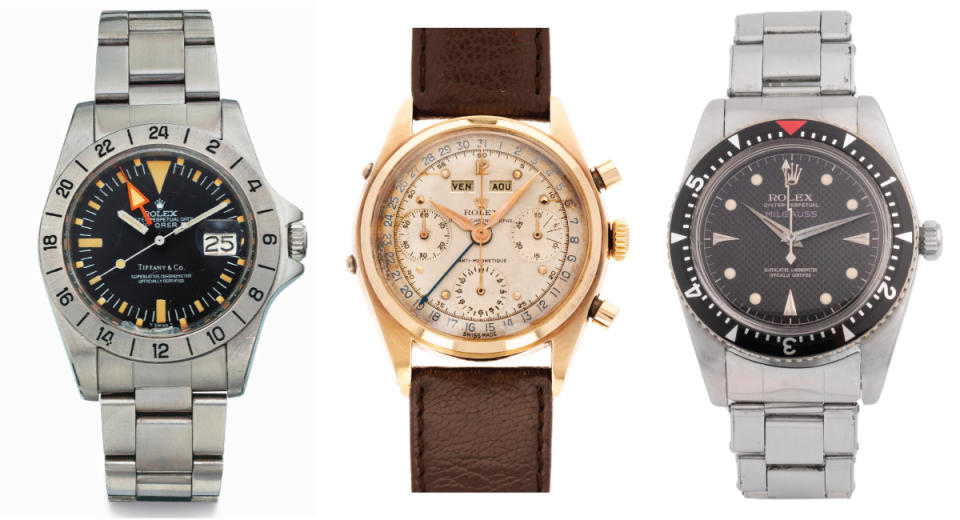
It may be difficult to imagine that a new watch from Rolex could have sat unsold gathering dust in display case, but back in the 20th century some shiny new Rollies indeed failed at retail. The models we discuss below flopped at different times for different reasons, but they are united today as some of the most coveted Rolex rarities. They now trade for astronomical sums among elite collectors, prices which spell out the ironic, ugly-duckling fate of these references.
These Rolexes are so valuable precisely because they originally flopped. As consumers passed on these watches, Rolex’s dealers placed fewer (or no) orders for them, and so Rolex made less and less until eventually updating or discontinuing the model. And that was that: Release…flop…gone.
Rolex has always been notoriously cagey about its production numbers, and some speculate Rolex didn’t retain sales records from its early decades. Collectors and aficionados often speculate about production numbers based on serial numbers, quantities gathered into collections, and (most flimsily) each other’s conjecture, but the fact remains that no one really knows exactly how many of these models ever existed or how many exist intact today. Know that the estimates we offer below are sometimes made by sellers incentivized to accentuate rarity.
What we do know is that these Rolexes are relatively rare, and that eager, wealthy collectors have dropped shockingly large sums to acquire these watches that no one really wanted back in the day.
Rolex 1803 Day-Date With Lilac Stella Dial
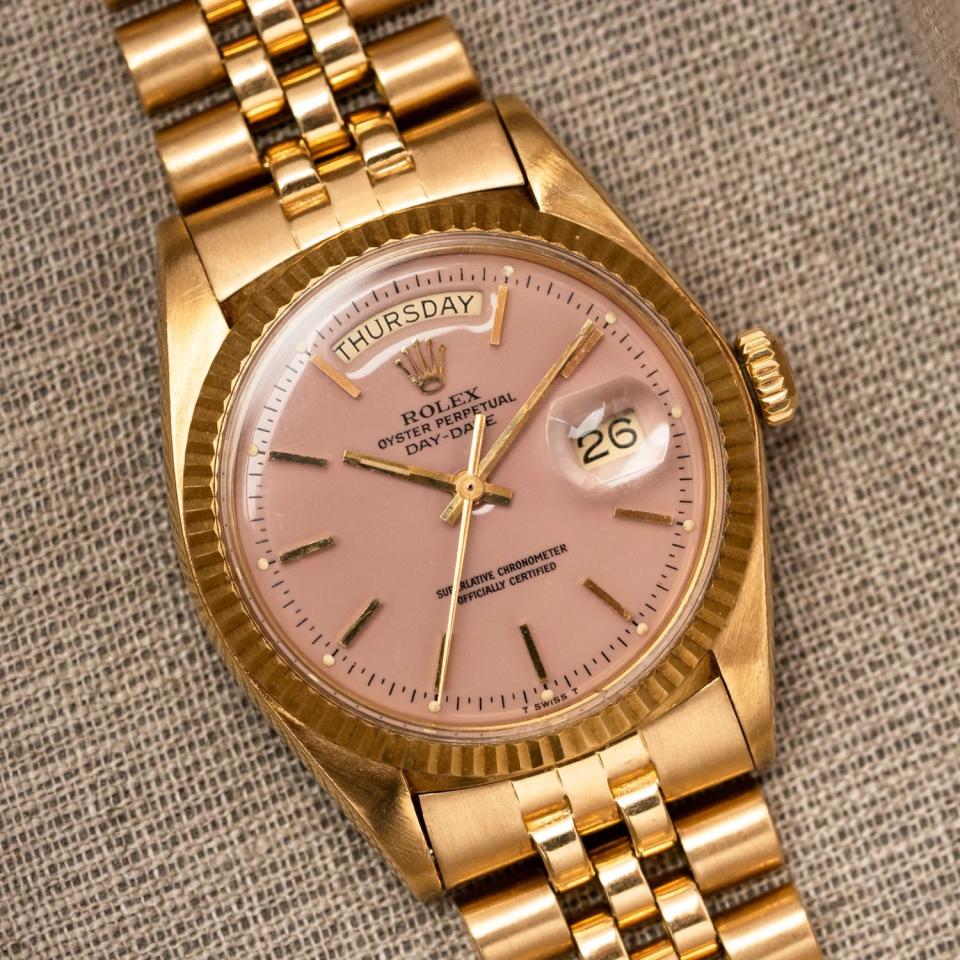
Amsterdam Vintage Watches claims that only four of these lilac watches are known to exist, and the Dutch house has one (pictured below) in their museum. To be clear, lilac is not the more common pink (or rose) Stella dial, but a pale purple.
Released in the mid 1970s, these colorful dials were Rolex’s first attempt to break out of its staid aesthetic and capture the playfulness of the moment (something we’re not sure is always a good idea for Rolex). ‘Stella’ refers to the company that produced the varnish used by the Stern dial company (owners of Patek Phillippe by then) to produce these lustrous finishes. This varnish is not hot-fired enamel, which people often mistakenly assume, but the varnish is fired at relatively low temperatures between coats to dry and harden it. A final clear coat goes on top, and then the silicon pad printing goes on top of that, creating a slight floating effect for the text over the dial.
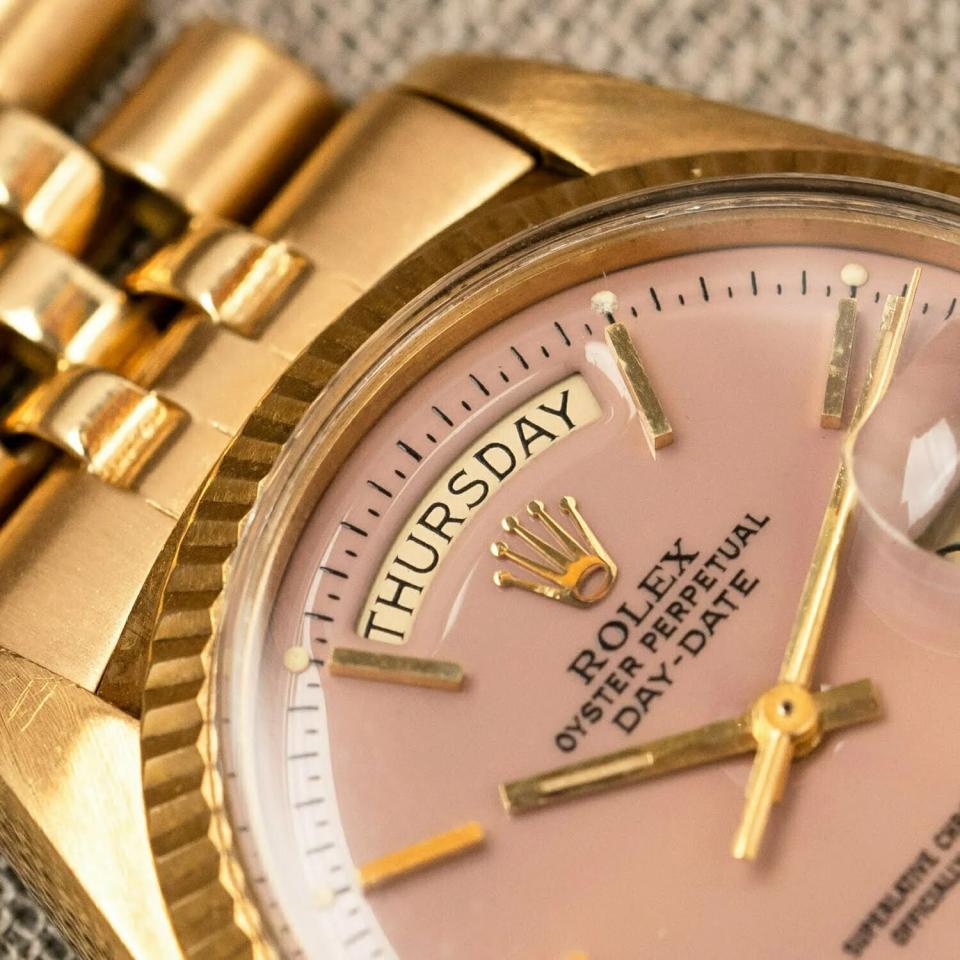
Rolex doesn’t appear to have thought these pastel offerings through very carefully, because the solid gold Day-Date was, in the early 1970s, the brand’s most complicated, expensive and establishment-oriented watch. The disco kids weren’t going to afford, or even want, the stodgiest of solid gold Rolexes. The more affordable steel Air-King or some such would have been a better candidate for youthful, post-flower-power, polyester-clad indulgence.
The watches are said to have sold abysmally, especially the lilac 1803. As a four-digit reference, the 1803 went out of production around 1978 and lacks a quick-set date function. It does sport a pie-pan dial—meaning that the outer minute track is angled downward in a manner said to resemble a pie-pan. Pie-pan dials were very popular in the 1950s and 60s, with Omega being especially known for them.
On May 9th of 2015, Phillips ran the “Glamorous Day-Date Auction” in Geneva. There a lilac 1803 Stella from 1976 sold for CHF 75,000 (around $82,000 at current exchange rate), while a “taxi yellow” version from 1977 sold for CHF 112,500 ($123,000). Whoever bought the lilac 1803 got the deal of the night, in my opinion, as that’s the rare one. The numbers achieved at this auction astounded the watch world and set the Stella on its upward trajectory.
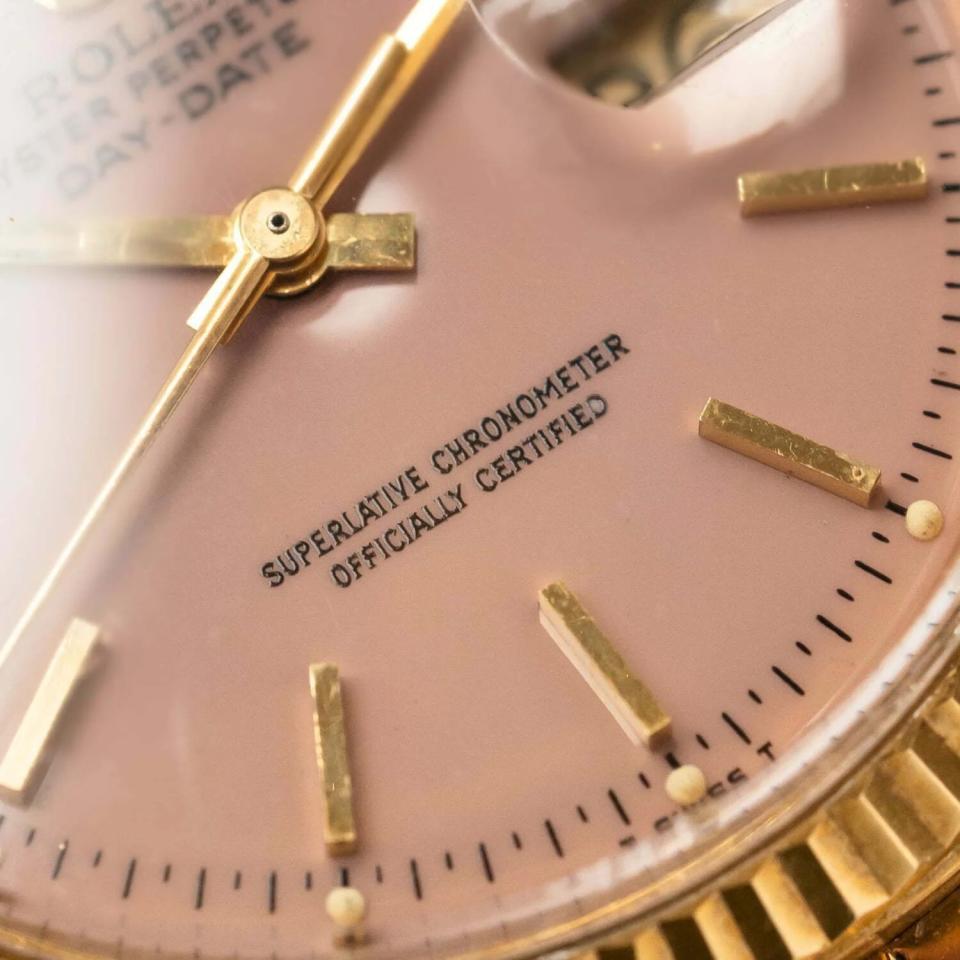
In 2022, a near-mint five-digit taxi-yellow Stella—a far more common color and reference dating to 1995—sold in Monaco for €650,000 ($695,500). It’s hard to imagine what the very rare lilac could hammer for these days. None we are aware of have come up for public sale since the aforementioned example sold in Geneva in 2015. If the four known examples are all that exist, then we can assume that if one were to go up for auction, it would have a good shot at passing the seven-figure mark.
Rolex King Midas 9630 (by Gerald Genta)
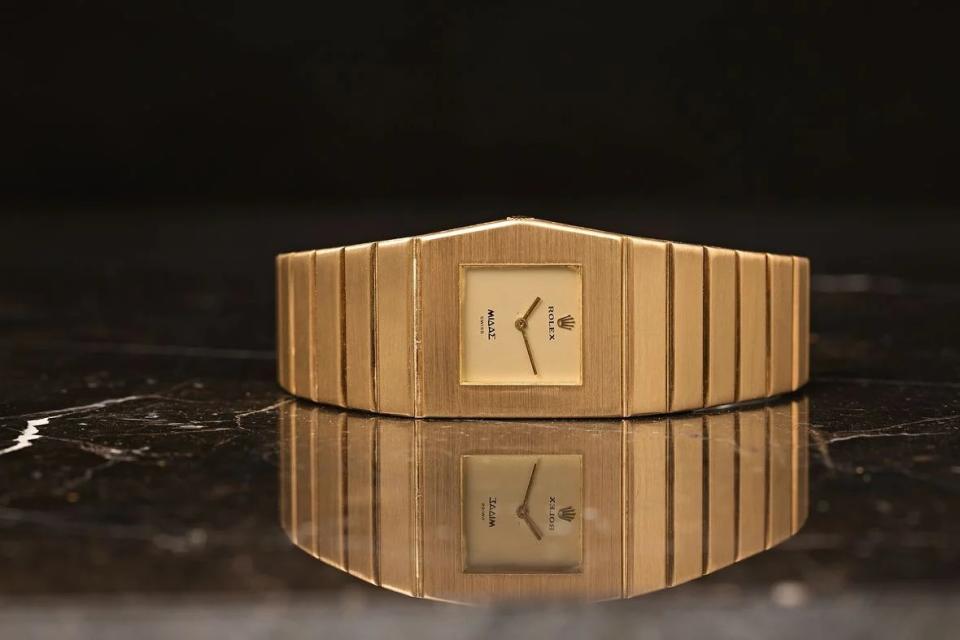
This solid gold integrated bracelet watch from non other than Gerald Genta’s pen weighed in at around 200 grams, making it a serious chunk of gold worthy of its name. Genta designed the watch to sit on its side and recreate the profile of the Parthenon in Athens, which is just so Genta.
But, like all these watches, the Midas flopped. As a limited edition of 1,000 in 1962, the reference 9630 ran just barely into the 1970s and never reached its proposed production goal of 1,000. Imagining that happening with any Rolex today gives you a sense of how these languished for nearly a decade—and that’s despite ownership by Elvis Presley, John Wayne, and an appearance in 1974’s James Bond film The Man With the Golden Gun.
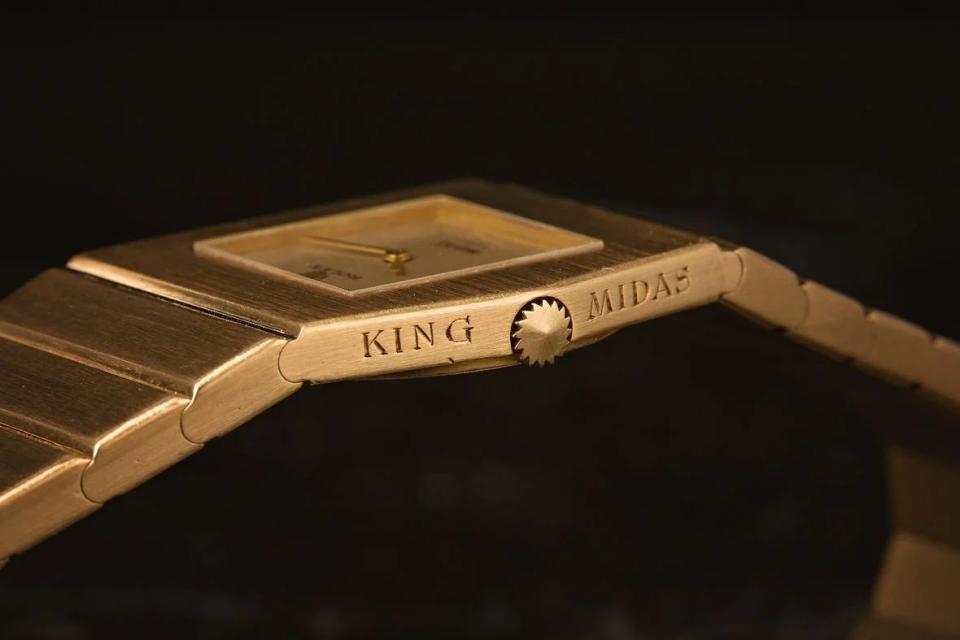
It wasn’t all that long ago that one could grab a King Midas for around $4000 (roughly the value of the gold melted down). We wish we had snatched them up. With the rise of the integrated bracelet watch, the recognition Genta has garnered as designer of Audemars Piguet’s Royal Oak, and today’s general fascination with small, gold timepieces, prices have approached $30,000 regularly.
Rolex Date Reference 1530
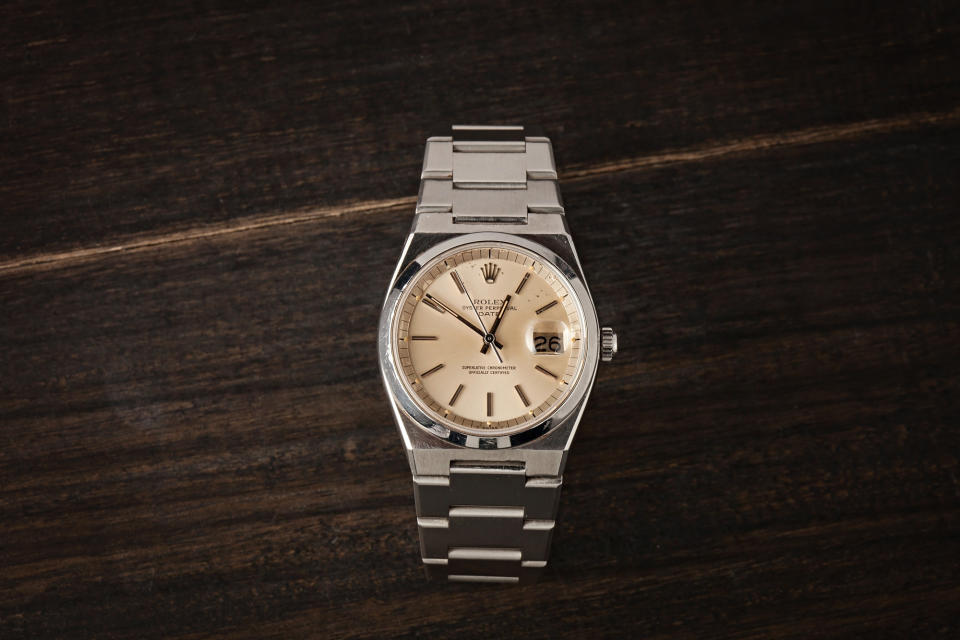
Another case of Rolex being a little late to a trend, the 1530 is essentially the mechanical predecessor of the Crown’s OysterQuartz. Rolex made very few 1530s in the mid 1970s before transitioning this style to the quartz-only offering.
Ten years ago, a patient hunter could sometimes snatch up a 1530 for hundreds of dollars, but—as with the King Midas before it—the 1530 is in vogue, and its flop at retail means not that many are out there. The two-tone 1630 is around, but most collectors are looking for the full-steel 1530 because integrated bracelet watches as a genre seem to call for steel above all else.
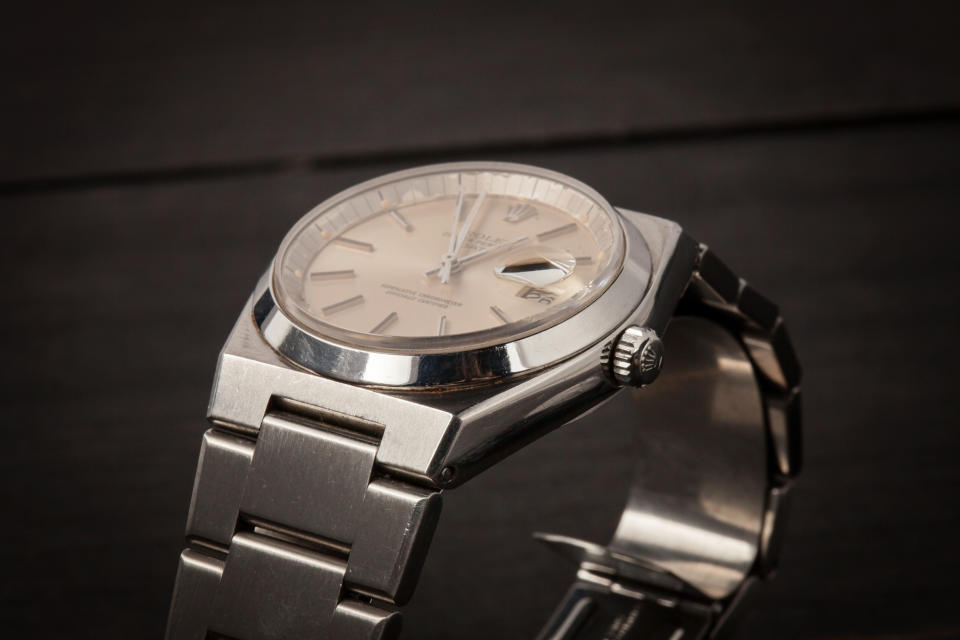
We can’t call the 1530 especially rare, but what was barely cresting into four-figures not long ago will, as of this writing, run you around $15,000 from most sellers, and the prices are only going up, despite recent softening of the vintage Rolex market more generally.
Rolex Milgauss 6451
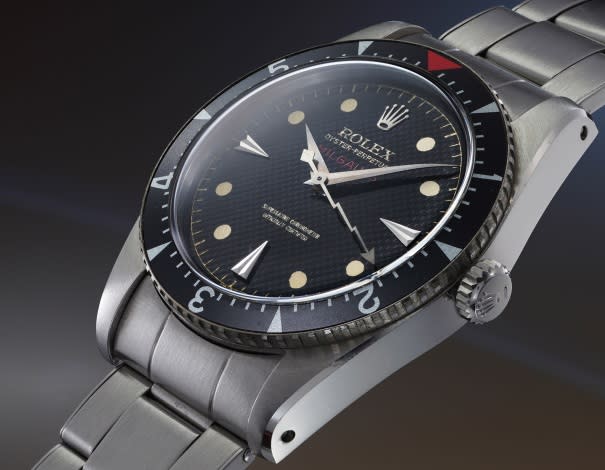
Distinguished as being the only Rolex model to have been discontinued twice, the Milgauss first ran from 1956 to 1988, and then from 2007 to 2013. The very first Millgauss, however, is the 37 mm reference 6451, which Rolex offered only from 1956 until 1959. That first Milgauss is increasingly hard to find, largely because serious Rollie collectors have snatched them up as essential members of prestigious collections.
As always, no one knows how many 6451s Rolex produced, and the speculation on that number ranges wildly enough for us to avoid further speculation. What we do know is that not many 6451s come up for sale these days, driving prices higher.
Why was the 6451 such a flop? Because of the antimagnetic Milgauss’ orientation to engineering and science, one could call the 6451 a Rolex for nerds. Compared to SCUBA diving (Submariner), climbing mountains (Explorer), racing cars (Daytona), or piloting jets (Air-King, GMT-Master), the Milgauss suggested one might sport a white lab coat accentuated with a pocket protector full of pens—not exactly the aspiring adventurer’s ideal. Even today with the popularity of the devilishly handsome Cillian Murphy in Oppenheimer, a scientist peering into a beaker isn’t something Rolex would plaster up on a billboard.
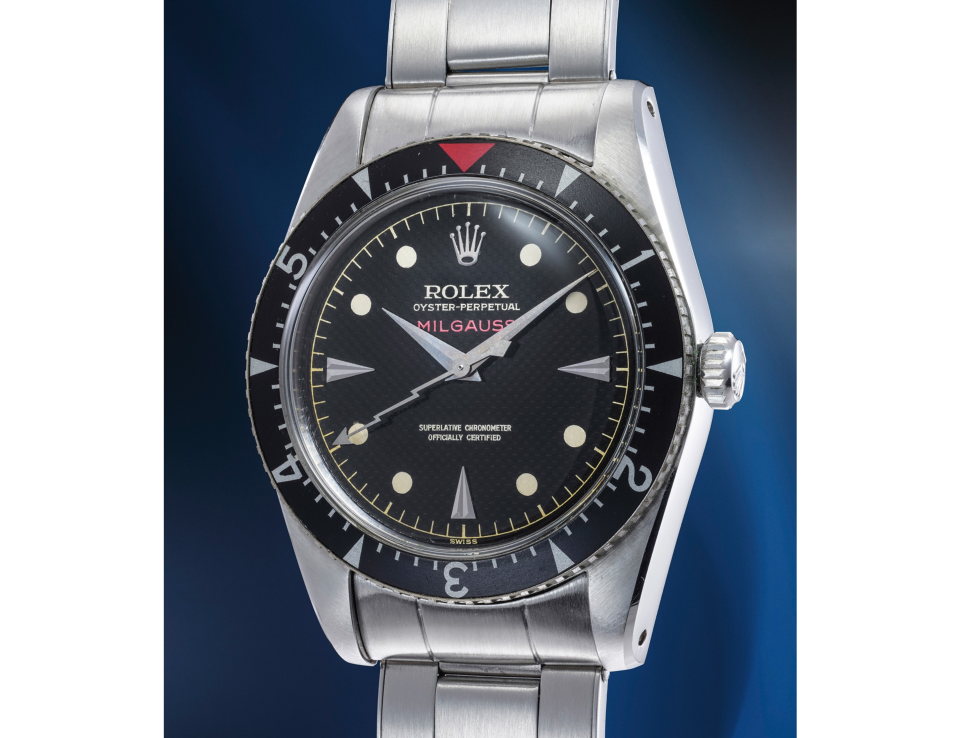
Flop it did, but the 6451 was a serious tool watch. Using the Oyster case and adding a rotating bezel, the original Milgauss was essentially a pre-Submariner with beefed up anti-magnetism. There were a few differences between the models though, including the 6451’s honeycomb pattern dial, dots and arrows for hour markers, a bright red MILGAUSS name across the dial, and the (now) iconic lightning bolt seconds hand—all of which make it a favorite among collectors today.
Phillips auctioned a 6541 with box and papers at the 2023 edition of the Geneva Watch Auction for a whopping CFH 2,238,000 (around $244,700 at current exchange rate), which was well over double the high estimate for the lot. That is the same watch you see in the images above.
“Jean-Claude Killy” Datocompax 6063 in Rose Gold
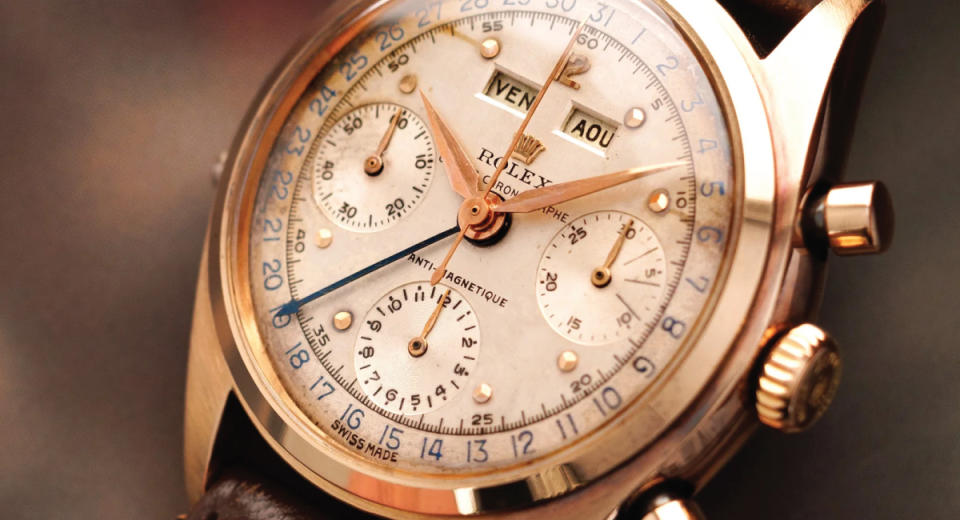
Sometimes a watch isn’t a flop at first, and then, as times and styles change, it starts to flop its way toward discontinuation. This is fair to say of the Rolex Datocompax, which ran in various iterations from the mid 1940s into the early 1960s—at which point it was long out of fashion. Even less fashionable were the reported 144 rose-gold examples of the Datocompax reference 6063 produced in the late 1950s and early 60s. Rose gold set the 1940s style of the Datacompax even further from the sporty, casual styles emerging in the 1960s.
Reference 6063 was the penultimate of many iterations of the Datocompax, the final reference being 6263. The 6063 used a two-piece Oyster case (sometimes called a monobloc), while the final iteration, reference 6263, used a three-piece case. Otherwise, the watches were almost indistinguishable, except for a few dial printing idiosyncrasies.
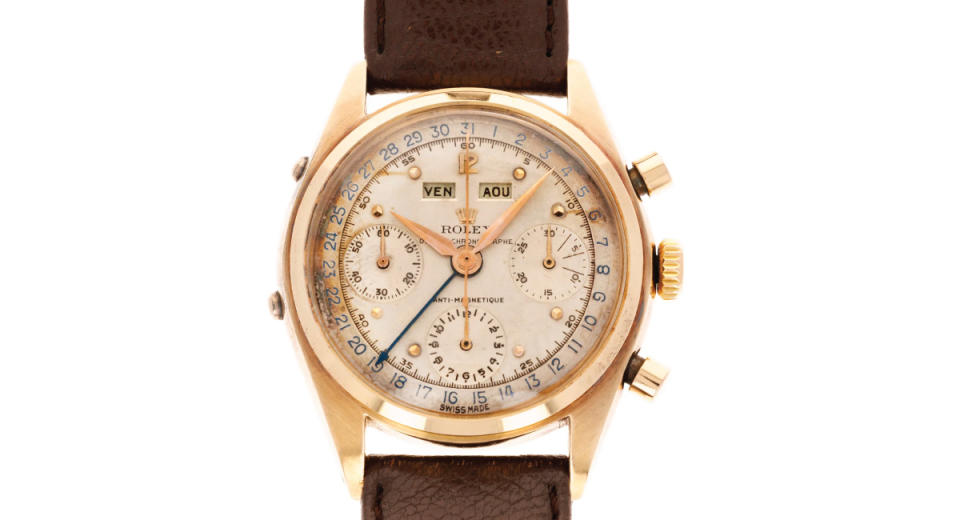
And perhaps that was the problem: The look badly needed an update. By the time the 6063 had come around, production had slowed to a crawl. According to hairspring.com, just 144 examples were produced in rose gold.
The name comes from French downhill skier Jean-Claude Killy, who took multiple golds at the 1968 Winter Olympics. At that point Rolex already had Killy onboard as an ambassador. His image was used in ads for the steel Datocompax during the early 1960s, but whether he wore one or not remains conjecture, as no photographic evidence has been found. But the name has stuck, and some collectors absolutely love these rare, complicated Rolexes.
On November 6th of 2023, Christie’s realized $478,800 for an English-market yellow gold 6063 on a three-link bracelet. Christie’s claims that watch is one of just 12 produced. As of this writing, the rose gold Italian-market version we’re looking at in the images here (courtesy of online seller thekeystone.com) is listed for $575,000. Keep your eyes open for these watches at auctions down the road, if only to watch them heat up the room.
Rolex Explorer II 1655 with Tiffany Dial
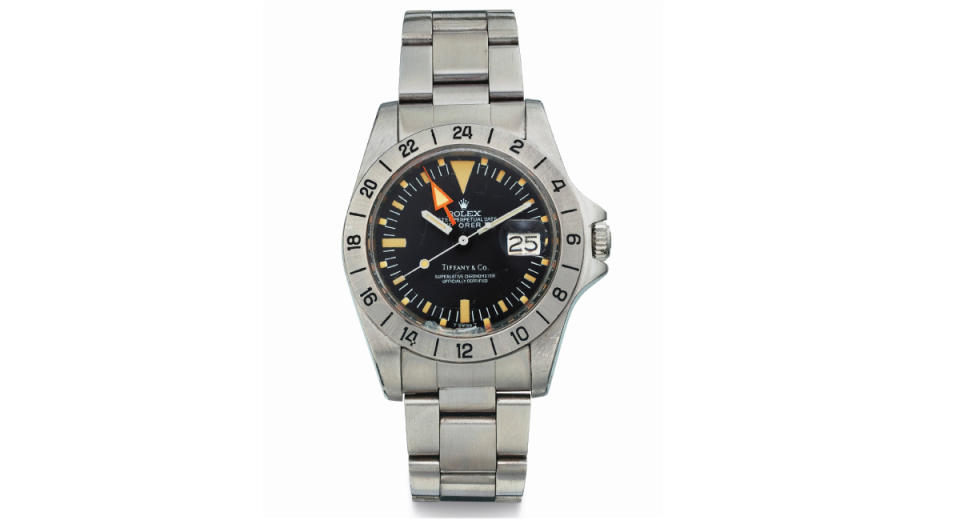
The Explorer II has always flown under the radar, and today the various references are known as the Rolex to get if you don’t want someone to notice you’re rocking a Rollie. As for why the original Explorer II was a bit of a flop generally, consider that it was designed for—and this always cracks me up—spelunking, or cave exploration. Niche anyone? Now add a Tiffany co-branding, and…well…what were they thinking?
The idea here was that the bright orange 24-hour hand could help a person spending more than 24 hours inside a cave determine whether it was night or day. But, as you might assume, it wasn’t exactly flying out the door in little green bags at the local Rolex dealership. But why anyone thought the Explorer II—dedicated to those who chose to crawl on their bellies inside the Earth—was a good match for Tiffany’s display cases remains one of the great horological mysteries of the 20th century.
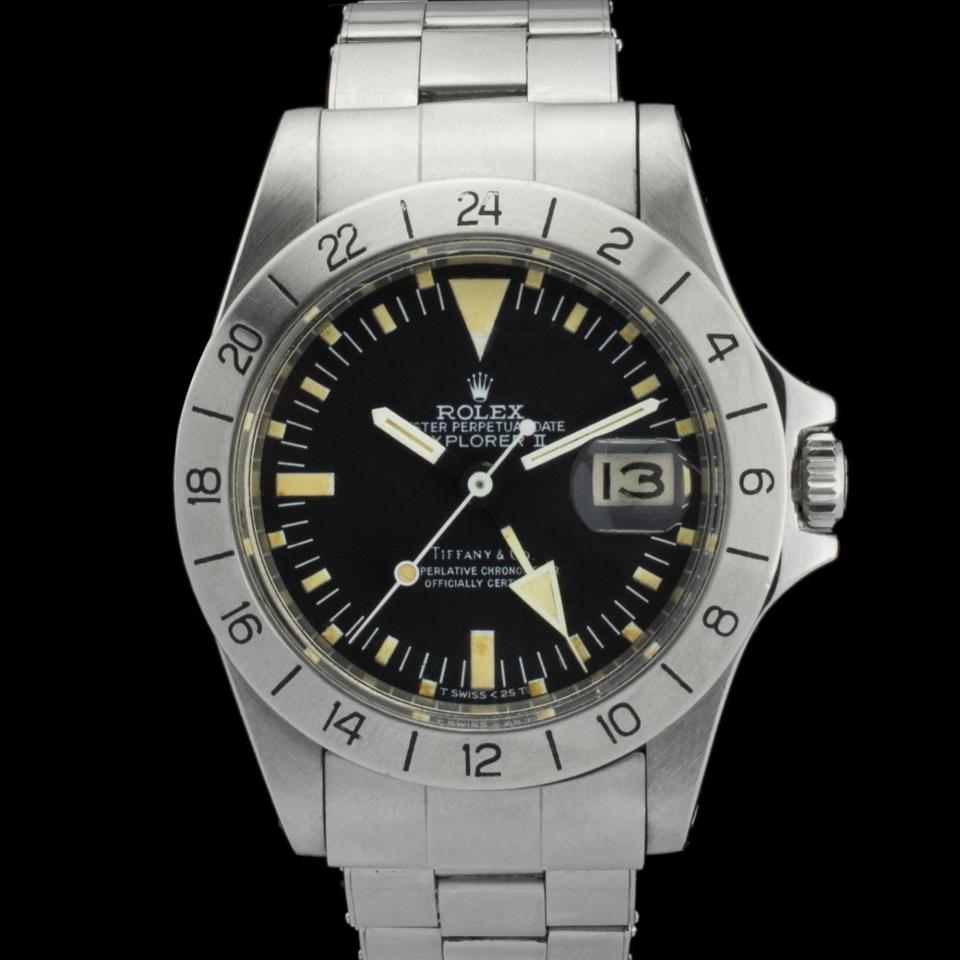
Once passed around for hundreds of dollars, as of this writing a clean example of an unsigned Explorer II 1655 is going to set you back somewhere north of $40,000. A very clean Tiffany-signed example went at Christie’s in 2019 for $60,000, and there is a faded “albino” Tiffany-signed 1655 headed up for auction with a high estimate of nearly $130,000.
Rolex Daytona 6239 “Paul Newman”
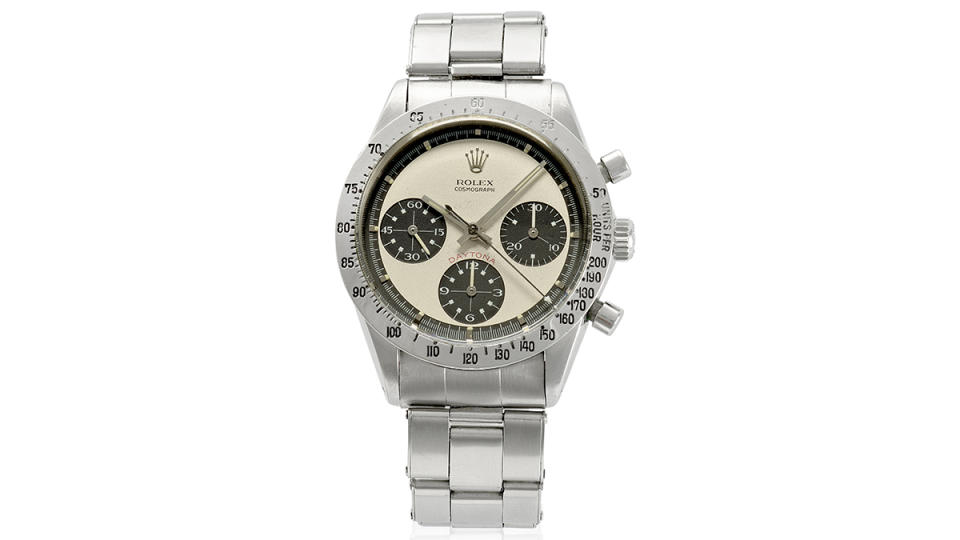
Last, but certainly not the least, we come to the ultimate flop that soared to become the most expensive watch in the world in 2017: the acclaimed Paul Newman Daytona. Known as reference 6239 until a few collectors in the late 1980s or 90s started to call it these watches the Newman Dial, this watch was fairly unpopular back when it was first released in 1963 as the Le Mans, and it didn’t get much more popular when it was rebranded as the Daytona the following year.
Most collectors and dealers estimate total production of the “exotic dial” (forever more the “Newman Dial”) at around 3,000 units total. Add in those lost and destroyed through use, and we’re not looking at a massive quantity up for sale on the vintage market—especially, when we factor in the Daytona-mania that ensued after Newman’s personal watch hammered for $17.8 million. As of this writing, various versions of the 6239 hover around the $50,000 to $70,000 range, but a clean example with papers and provenance can peak up over $250,000. Not bad for a watch that wasn’t very popular and originally cost around $400.
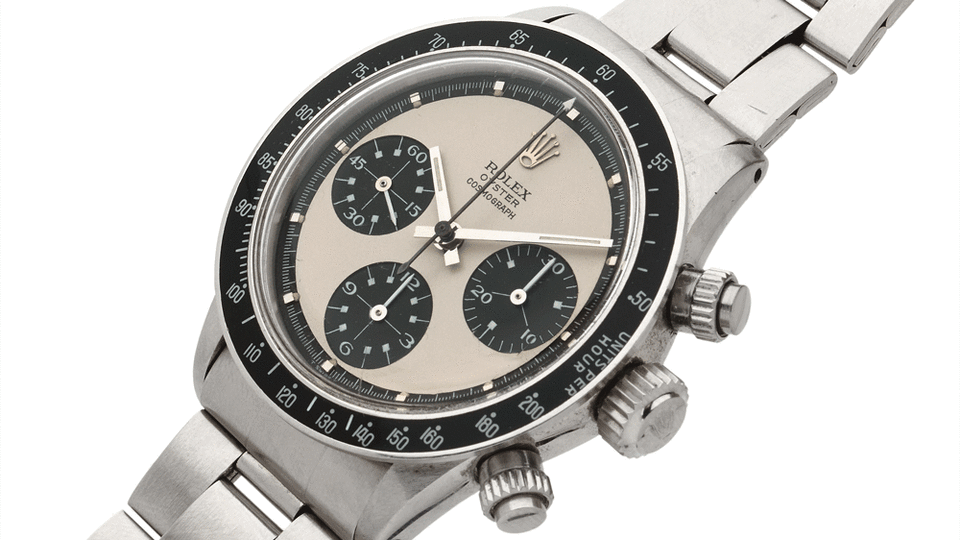
Best of Robb Report

